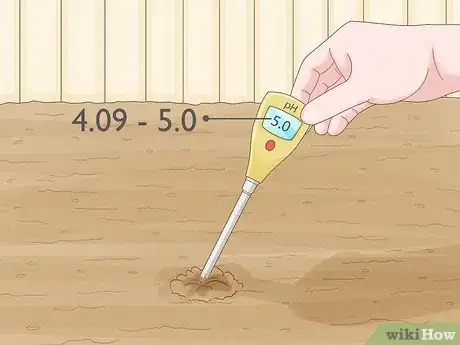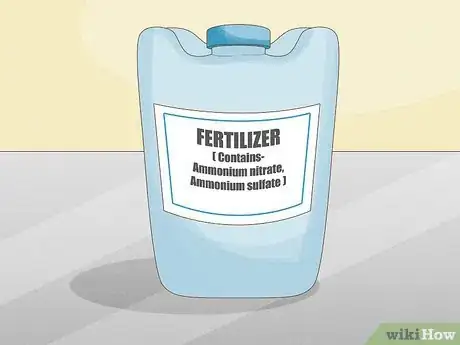wikiHow is a “wiki,” similar to Wikipedia, which means that many of our articles are co-written by multiple authors. To create this article, 14 people, some anonymous, worked to edit and improve it over time.
wikiHow marks an article as reader-approved once it receives enough positive feedback. In this case, 100% of readers who voted found the article helpful, earning it our reader-approved status.
This article has been viewed 65,957 times.
Learn more...
This article explains what to do to fertilize your homegrown blueberry plants successfully, by adjusting to improve the soil acidity, using healthy plants and ensuring that they are well positioned to ensure that the bees and other insects pollinate them with ease.
Steps
-
1Start right with blueberries. Blueberries bring a unique combination of delicious fruit and striking ornamental beauty to the garden and landscape. Blueberries are easy to grow, require little care, and are seldom bothered by pests. If a few basic steps are followed, your blueberry plants can thrive and last a lifetime.
-
2Choose a suitable variety of blueberry. Blueberry varieties are distinguished by their climate suitability and ripening season. Be sure to choose varieties suited to your area.[1]
- You may want to select varieties that ripen at different times or feature large fruit (best for fresh eating and desserts) or small fruit (best for muffins and pancakes). Bushes with brilliant fall color or different growth habits offer the gardener lots of choices to use throughout the landscape.
- For blueberry lovers, allow at least two plants per family member.
Planting for optimal fruits
-
1Plant in full sunlight. The blueberries need plenty of sunlight, whenever it begins to branch or bramble.[2]
-
2Ensure sufficient drainage. Adequate soil drainage is important. Find a suitable site, avoiding low lying areas the collect water or are slow to drain in the spring.[3]
-
3Select the right site. Select a sunny location in well drained soil free of weeds and well worked. Locate in an area where irrigation water is available as best results will be obtained by keeping the root zone moist throughout the growing season. Where the soil is poor or marginally drained, raised beds 3–4 feet (0.9–1.2 m) wide and 8-12" high work very well for blueberries.A fail safe way to grow blueberries in almost any soil is to incorporate peat moss into the planting medium.
- For planting directly in the ground, work up a planting area approximately 2-1/2 feet in diameter and one foot deep. Remove 1/3 to 1/2 of the soil. Add an equal amount of pre-moistened peat moss and mix well.
-
4Mulch well. Blueberries do best with a 2-4" mulch over the roots to conserve moisture, prevent weeds and add organic matter.[4] Bark mulch, acid compost, sawdust, grass clippings, etc. all work well. Repeat every other year.
-
5Ensure pollination for the blueberry plants.[5] Blueberries cannot be fertilized by their own pollen. Most fruit trees, including blueberries have both male and female organs on the same flower, but not all are self pollinating.The best bet for blueberries is to have different varieties of blueberries within 100 feet (30.5 m), so bees can travel and cross pollinate.
Fertilizing the blueberries
-
1Fertilize at the right time. Spring is the best time, before the leaves grow.[6] Apply in early spring and again in late spring for best results.
-
2Have the soil tested. You won't know how to correct it for the sake of better blueberry plants. Almost all fruits do best in slightly acidic soil, somewhere between a pH of 5.5 and 6.5. Blueberries prefer a soil of even greater acidity of between 4.09 and 5.0. The soil acidity is an important part of proper fertilization of the blueberries.
- Blueberries thrive in acidic soils. One 4-cubic foot compressed bale will usually be sufficient for four to five plants, for raised beds mix equal volumes peat moss with acid compost or planting mix. Your garden center representative can recommend a soil acidifier if necessary for your soil.
-
3Select a fertilizer appropriate for blueberries. This plant likes acid fertilizers such as rhododendron or azalea formulations. Choose a fertilizer high in nitrogen. However, the fertilizer must not contain calcium nitrate or chloride as these can kill some blueberry plants.[6] The fertilizer should contain ammonium nitrate, ammonium sulfate or sulfur-coated urea. These ingredients ensure that the pH is lower and the acid level higher.
- For newly planted stock, use 2 tablespoons of 10-20-10 (or similar fertilizer) in late spring or once plants are established. Be careful! Blueberries are very sensitive to over fertilization.
- For subsequent years, use 1 ounce of fertilizer for each year from planting to a total of 8 ounces per plant.
- For organic fertilizers, blood meal and cottonseed meal work well. Or you can use the following:
- Fish meal or bone and blood meal for nitrogen.
- Bone meal and powdered seaweed can add potassium and phosphorous.
- Coffee grounds or sphagnum peat can increase acidity.
- Avoid using fresh manure.
-
4Water in. Always water well after fertilizing.
-
5Ensure that the blueberry plant is not deficient in iron or magnesium. If you see red to yellow leaves, this signifies a deficiency in magnesium, while yellow leaves with green veins signifies a possible iron deficiency.[6] The fertilizer should contain either or both of these nutrients, as required.
Community Q&A
-
QuestionCan I fertilize with berries on the plant?
 DonaganTop AnswererYou can fertilize anytime, but late winter/early spring is best.
DonaganTop AnswererYou can fertilize anytime, but late winter/early spring is best. -
QuestionDo I need to prune the plants?
 NinoxTop AnswererNo, you don't have to. You can simply cut the dead wood and embarrassing twigs in the winter.
NinoxTop AnswererNo, you don't have to. You can simply cut the dead wood and embarrassing twigs in the winter. -
QuestionQuestion regarding bulleted advice at part 2.2: a "4-cubic-foot compressed bale" of what?
 NinoxTop AnswererHay bale. It acidifies the soil for the blueberries. You can also use ericaceous compost if you don't have hay.
NinoxTop AnswererHay bale. It acidifies the soil for the blueberries. You can also use ericaceous compost if you don't have hay.
References
- ↑ https://www.almanac.com/plant/blueberries#
- ↑ https://www.burpee.com/gardenadvicecenter/fruit/blueberries/how-to-grow-blueberry-plants/article10389.html
- ↑ https://www.burpee.com/gardenadvicecenter/fruit/blueberries/how-to-grow-blueberry-plants/article10389.html
- ↑ https://www.almanac.com/plant/blueberries
- ↑ https://www.noursefarms.com/how-to-grow/blueberries/
- ↑ 6.06.16.2http://www.gardeningknowhow.com/edible/fruits/blueberries/blueberry-fertilizer.htm
About This Article
To fertilize blueberries so they thrive, start before the leaves begin to grow in spring. It's best to fertilize the blueberries at the start of spring and then again at the end of the season. Choose an acid fertilizer that’s high in nitrogen. Rhododendron or azalea fertilizers are ideal. Avoid any fertilizers that contain calcium nitrate or chloride, as these chemicals are harmful to blueberry plants. Apply the fertilizer according to the instructions on the package and make sure to follow them closely as blueberries can suffer from overfertilization. For more information on fertilizing blueberries, like how to choose an optimal plant, read on!





















-Step-10-Version-3.webp)
















































